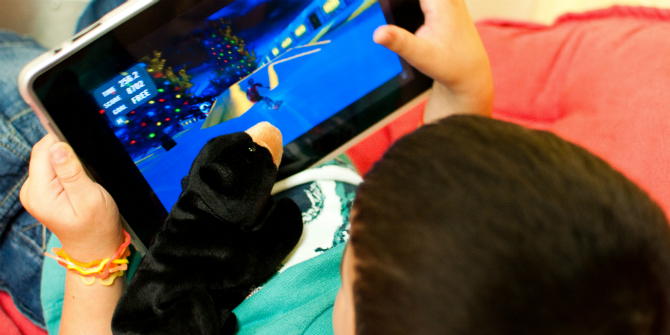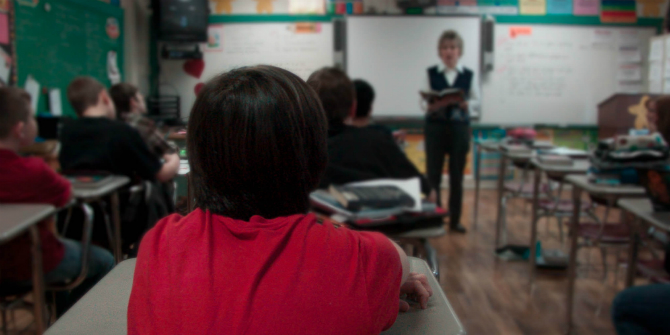 This post explores sharenting as it relates to celebrity parents. Beyond the usual concerns of parents (over)sharing about their children online, for celebrities, sharenting can become a monetised practice where children are often used as the face of brands and campaigns. Ana Jorge and Lidia Marôpo have studied the topic of children of celebrities since 2010, and suggest combining a rights-based approach and a public health model to address the dilemma between publicity vs privacy. Ana is Assistant Professor at Universidade Católica Portuguesa and Lidia is Assistant Professor at Polytechnic Institute of Setúbal. [Header image credit: Nate, CC BY-NC 2.0]
This post explores sharenting as it relates to celebrity parents. Beyond the usual concerns of parents (over)sharing about their children online, for celebrities, sharenting can become a monetised practice where children are often used as the face of brands and campaigns. Ana Jorge and Lidia Marôpo have studied the topic of children of celebrities since 2010, and suggest combining a rights-based approach and a public health model to address the dilemma between publicity vs privacy. Ana is Assistant Professor at Universidade Católica Portuguesa and Lidia is Assistant Professor at Polytechnic Institute of Setúbal. [Header image credit: Nate, CC BY-NC 2.0]
In 2010, Portuguese football player and global celebrity Cristiano Ronaldo announced on Facebook and Twitter that he had had a son by a woman who was to remain anonymous, which resulted in great media buzz. His now six-year-old son, Cristiano Junior, is constantly visible in his father’s social media pages, as well as in celebrity media.
In analysing how children of celebrities are represented in celebrity magazines in Portugal and Brazil, and in global celebrity online media, we found a cultural fascination with newborns and very young children in particular. Additionally, we found that celebrities’ children are mostly shown with parents’ consent (in staged photography, or with ‘fake paparazzi’), usually with the family shown as happy and affectionate, constructing an idealised form of parenthood.
Over the last few years, as elsewhere, Portuguese celebrities have turned to social media such as Facebook, Instagram or YouTube as a direct way to communicate with – and receive feedback from – their audiences and fans on their private lives as well as on their work. Through its ‘in-the-momentness and self-authorship’, social media is presented ‘as more transparent and honest’, even if celebrities have professional agents and managers responsible for their online visibility. As the media crisis in Portugal in advertising and sales put an end to permanent and well-paid contracts for celebrities, social media offers a way for them to make a profit by endorsing products.
Audiences and media have always been interested in celebrities’ private and family lives. Nowadays, celebrities’ posts are often picked up by media as a convenient way to feed multiple platforms, acting as ‘clickbait’. The ‘regular’ paparazzi has been almost dispensed with (again, for financial reasons). Citizen paparazzi, (with widespread mobile technology) are not common, as celebrity and news media aren’t prepared to risk lawsuits for publishing photos of children without the famous parents’ – or their agents’ – consent. Lawsuits are in effect rare, because most of what is published has already been negotiated in advance by the media outlets, who rely on the celebrities as much as the reverse.
‘Sharenting’ vs. children’s rights
Sharenting has mostly been discussed from the parents’ perspective (particularly mothers), allowing them to reflect on the experience of being a parent while building community and relationships. Indirect benefits of sharenting include commonality and support, advocacy for children, curating memories and an opportunity for parents to manage their work–life balance, as it becomes a ‘family business’. This ‘professionalisation of motherhood’ includes exploitation of lifestyle and consumption as the sharing of content also generates income for some parent bloggers, or helps support the formation of a celebrity ‘brand.’
But to what extent does this public visibility threaten the rights of these children? Could their digital presence cause problems in their present or future lives? What are the implications for these children of the monetisation of social media, and how can negative comments be managed?
These are even more critical questions when we talk about celebrities’ children, where the extent of their exposure is huge. Added to the potential risks for children (over)exposed in social media, such as stranger danger, embarrassing situations or unwanted surveillance and criticism, children of celebrities face additional threats. As they have no control over the content published about themselves, their online presence may have more social and mainstream media repercussions, generating public criticism about their lifestyle. Furthermore, they have a digital footprint before they are even able to consent, with intimate moments shown, identifying children’s names, faces, age and places where they circulate.
From a rights’ perspective, celebrities and the industries they work for decide on their children’s visibility, while the children have no control over what is shared about them. From a law perspective, Stacey Steinberg discusses this intersection between the right of parents to share their online parenting experience and their children’s privacy, arguing that parents should recognise and respect the importance of their children’s digital identity.
Another important topic to be considered is the commercial content promoted by celebrities. Their children’s images are used in blogging and social media to advertise products and brands, showing how sharenting is becoming increasingly monetised, professionalised and industrialised for celebrities, or ‘micro-microcelebrities’, as Crystal Abidin states, i.e. celebrities and online celebrities are engaging more and more in the sphere of commercial promotion involving their young children.
How celebrities manage the risks of sharenting
This sharenting could also encourage intrusiveness and harassment from the paparazzi, meaning that children from A-list celebrities grow up under permanent surveillance. Looking at Portuguese celebrities with blogs that focus on their family life, we discovered, however, that celebrity parents share their experiences of parenthood – especially motherhood – and don’t show their children’s faces. Instead, they use pictures in decontextualised locations, while depicting intimate moments and talking about episodes as their children grow up.
How to solve the dilemma of publicity vs privacy
Inspired by Sonia Livingstone’s approach to children’s digital media practices, we suggest that the debate on a rights-based approach must be extended from the children’s use of digital media to their parents (and others) using digital media. How can we adapt the usual language of protection, provision and participation rights to this context?
A complementary contribution to the debate would be a public health model of child protection through the advocacy of best practice. Since usually available legal protections are ineffective, and admitting that most parents (including celebrities) have not yet taken into consideration the importance of children’s digital identity, safe practices must be promoted. These could include:
- Caution in sharing a child’s actual location
- Child ‘veto power’ over online disclosures (including images, quotes, accomplishments and challenges)
- Attention to the effect shar(ent)ing can have on a child’s current and future sense of self and wellbeing.
Children of celebrities and even micro-celebrities can be seen as a priority group for advocacy towards respecting children’s rights while sharenting.
This post gives the views of the authors and does not represent the position of the LSE Parenting for a Digital Future blog, nor of the London School of Economics and Political Science.





